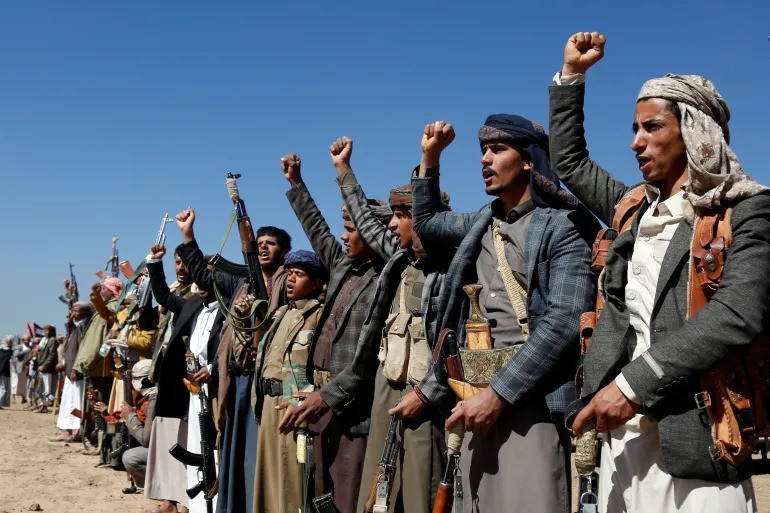The Houthis’ acquisition and deployment of ballistic missiles represent a complex interplay of regional dynamics, international relations, and local factors. Here’s a detailed analysis of how the Houthis came to possess and deploy these advanced weaponry:
1. Background of the Houthis
The Houthis, formally known as Ansar Allah, are a Zaidi Shia insurgent group from northern Yemen. They emerged in the early 2000s, initially advocating for the rights of the Zaidi Shia community and opposing the Yemeni government’s corruption and neglect. The group’s military and political power grew significantly, culminating in their takeover of Yemen’s capital, Sanaa, in 2014, which precipitated the ongoing civil war.
Read More: Geopolitical Machinations: India and Russia Strengthen Ties as China Takes Note
2. Iranian Support and Influence
a. Strategic Alliance
Iran’s support for the Houthis is rooted in its broader strategy to counterbalance Saudi Arabian and Western influence in the Middle East. This support aligns with Iran’s goal of expanding its regional influence and fostering proxy relationships that can exert pressure on its adversaries.
b. Provision of Ballistic Missiles
Iran has been a key supplier of ballistic missile technology to the Houthis. This support includes not only the provision of missile systems but also technical expertise to assemble and operate these systems. Reports and analyses suggest that Iran has supplied the Houthis with various types of ballistic missiles, including Scud variants and more advanced designs.
3. Smuggling Networks
a. Arms Smuggling Routes
The Houthis have acquired ballistic missiles through extensive smuggling networks. These networks facilitate the movement of weaponry from Iran and other sources to Yemen. The missiles often enter Yemen through maritime routes or via neighboring countries. The difficulty in monitoring and policing these routes has enabled the Houthis to amass and deploy advanced weaponry.
b. Regional Proliferation
The proliferation of weapons in the region, including through illicit channels, has contributed to the Houthis’ capabilities. The chaotic environment in Yemen, combined with the involvement of multiple external actors, has made it challenging to restrict arms flows effectively.
4. Local Adaptation and Capabilities
a. Technical Expertise
The Houthis have developed significant technical expertise over time. They have managed to assemble, modify, and deploy ballistic missiles, often incorporating adaptations to suit their operational needs. This expertise has been bolstered by support from Iran and possibly other actors.
b. Indigenous Production
There is evidence that the Houthis have also engaged in some level of indigenous production or modification of missiles. This includes adapting captured or smuggled weapons to increase their range or effectiveness.
5. Conflict Dynamics
a. Escalation of the Yemeni Civil War
The escalation of the Yemeni conflict has driven various factions, including the Houthis, to seek advanced weaponry. The Houthis’ control of key areas and their desire to assert power have led them to deploy ballistic missiles as a means of enhancing their military capabilities and negotiating leverage.
b. Use Against Saudi Arabia
The Houthis have used ballistic missiles to target Saudi Arabia and its coalition partners. This tactic is aimed at exerting pressure on Saudi Arabia, which leads a coalition supporting the Yemeni government against the Houthis. The ability to strike deep into Saudi territory represents a significant escalation and serves to enhance the Houthis’ strategic leverage.
6. International Response and Sanctions
a. Arms Embargoes
The international community, including the United Nations, has imposed arms embargoes and sanctions targeting the Houthis and their suppliers. However, enforcement has been inconsistent, and the smuggling routes remain difficult to control.
b. Monitoring and Enforcement Challenges
The effectiveness of international monitoring and enforcement efforts has been limited by the conflict’s complexity and the difficulty in policing smuggling routes. This has allowed the Houthis to continue receiving and deploying advanced weaponry despite international efforts to curb their access.
7. Implications and Consequences
a. Regional Security Dynamics
The Houthis’ ballistic missile capabilities have significant implications for regional security. They represent a new dimension in the conflict, with the potential to affect the strategic calculations of regional powers, particularly Saudi Arabia and Iran.
b. Humanitarian Impact
The use of ballistic missiles in the conflict exacerbates the humanitarian crisis in Yemen. The targeting of civilian areas and infrastructure contributes to the suffering of the Yemeni population and complicates efforts to reach a political resolution.
Read More: Narendra Modi’s 3.0 Foreign Policy: Pak, China, Western Countries
Conclusion
The Houthis’ possession and deployment of ballistic missiles result from a combination of Iranian support, sophisticated smuggling networks, local technical adaptation, and the dynamics of the Yemeni civil war. Their ability to utilize these weapons reflects broader geopolitical rivalries and has significant implications for regional stability and humanitarian conditions.







